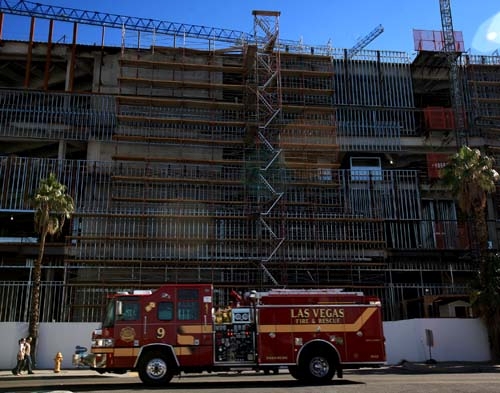Firefighters conduct drills at Fontainebleau

There are metaphors, and then there are metaphors.
Las Vegas representing the get-rich-quick American Dream? That’s a metaphor.
Transforming a $3 billion victim of the city’s economic flameout into an experiment in fire fighting? That’s a metaphor with a capital M.
It’s not clear who came up with the clever, cheeky idea, but earlier this month, roughly 2,000 firefighters from Clark County and municipalities including Las Vegas, North Las Vegas and Henderson took their annual regional drill to the vacant Fontainebleau’s 32nd floor, where theatrical smoke muddled the air and mimicked turbid fire fighting conditions. The exercises concluded Tuesday.
“It’s such a unique opportunity. It’s rare that you get a chance to practice in a 68-story, 24-acre megaresort property on the Las Vegas Strip,” said Russell Cameron, deputy fire chief of the Clark County Fire Department, which coordinated this month’s exercise. “Icahn (Enterprises) really took care of us.”
Icahn Enterprises, a company belonging to corporate investor Carl Icahn, bought the 3,900-room Fontainebleau a year ago after financial struggles halted construction on the project.
The resort’s original developer, an affiliate of Turnberry Associates of Florida, was about $2 billion in and 70 percent finished when, in March 2009, lenders cut off $800 million in funding the company needed to complete the job. Along with the abandoned hulk of steel framing punctuating the dormant Echelon site down the street, the shuttered Fontainebleau quickly became a symbol of the city’s economic crash and burn. Icahn scooped up the Fontainebleau for about $150 million, or 5 percent of the development’s initial construction price tag.
Now that’s what they call a fire sale! (Sorry.)
Icahn didn’t return a call seeking comment on the fire fighting deal before press time.
But David Schwartz, director of the Center for Gaming Research at the University of Nevada, Las Vegas, called the arrangement a silver lining in the Strip’s cloudy economic climate.
“It’s efficient,” he said. “If you’ve got this big, empty structure, what better way to use it than to train people to save lives?”
Bill Thompson, a UNLV professor who studies gambling, said this kind of drill has the potential to remind tourists of images the city’s leaders would rather they forget. He saw a report covering the drills on a national news network earlier this week, and the television story featured 2008 footage of the Monte Carlo’s roof-level facade in flames.
“It’s really nice that we have safety drills and we’re doing practices, but it’s not something we want the tourists to be thinking about when they come here,” Thompson said. “When we bring up hotel fires, or even robberies like the Bellagio robbery (in December), that kind of publicity isn’t good for us.”
This wasn’t the first time the Fontainebleau stood in as a towering inferno for local firefighters.
Back in October 2009, before Icahn owned it, The Fontainebleau hosted a similar regional event for the city of Las Vegas Fire and Rescue squad.
During those and the most recent drills, area fire fighting agencies performed test runs on command-and-control operations while firefighters practiced deploying hose lines, maneuvering amid smoke with heavy equipment and sending communications via radio systems.
In the most recent exercise, Icahn offered the resort’s services for free, with the stipulation that the departments fix any damage done during training. The agencies don’t set actual fires, and the stage-effect smoke doesn’t leave soot streaks, but bulky gear can ding concrete or punch holes in drywall.
“Basically, we ensure that the condition will be reasonably similar to the way it was prior to the drill,” Cameron said. “We do a walk-through with the owners afterward to make sure no damage did occur. We deliver it back to them just like we would want it delivered.”
Nor is Fontainebleau the only resort that local fire agencies have used for training. They’ve conducted practice runs at the Golden Palm Hotel on West Tropicana Avenue, at Texas Station and at Caesars Palace, among others, though if they need other empty properties besides the Fontainebleau, we hear Vdara’s an option.
Just kidding!
Sort of.
Unlike those other drill sites, the Fontainebleau is pretty much devoid of all resort-like accoutrements — Icahn’s group sold most of the furniture last fall, a move that some analysts said indicates he doesn’t expect a near-term recovery on the Strip.
Other observers have estimated that it will take at least $1 billion to finish the Fontainebleau and its casino, shopping center, restaurants and spa, among other features.
Cameron, who’s seen some of the property’s finished rooms, assures us it’ll be “absolutely magnificent” when it’s done.
He’s also torn between seeing fire departments’ training programs benefit from the collapse of an important local megaresort, and his concern for the city’s broader economic health.
“My feelings are, we have 37.5 million visitors in this community, and the economy of this community is extremely important,” he said. “The best-case scenario is always going to be that businesses are thriving and the city is doing the best that it can.”
That said, it’s also important to cultivate consumer confidence in the ability of Southern Nevada to keep its hotel guests safe, Cameron noted. And because there’s so much practical value in clambering up a real, live skyscraper in a non-emergency practice run, Cameron said local fire departments hope to visit the Fontainebleau for similar drills in early 2012 — as long as it’s not yet built out and full of guests.
We’re guessing that won’t be a problem.
Contact reporter Jennifer Robison at jrobison@reviewjournal.com or 702-380-4512.